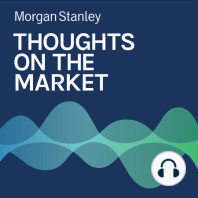3 min listen
Labor: Are People Returning to Work?
ratings:
Length:
5 minutes
Released:
Nov 3, 2022
Format:
Podcast episode
Description
As developed markets heal from the pandemic, labor force participation has recovered in some areas faster than others, so how will a return to work impact the broader economy in places like the U.K. and the U.S.? U.S. Economist Julian Richers and European Economist Markus Guetschow discuss.----- Transcript -----Julian Richers: Welcome to Thoughts on the Market. I'm Julian Richers from the Morgan Stanley U.S. Economics Team. Markus Guetschow: And I'm Markus Guetschow from the European Economics Team. Julian Richers: On this special episode of the podcast, we'll focus on the issue of labor force participation across developed markets and its broader economic implications. It's Thursday, November 3rd, at 10 a.m. in New York. Markus Guetschow: And 3 p.m. in London. Markus Guetschow: It's no secret that the COVID pandemic profoundly disrupted labor markets across the globe. Labor shortages, rather than unemployment, have now become the key challenge to economies everywhere, and the 'great resignation' has become a catchphrase. In the U.K. and U.S. in particular, are experiencing a slow recovery in labor participation post-COVID, which is adding to an already complex set of policy trade offs by the Fed and the Bank of England. At the same time, Europe looks like a bright spot. So Julian, 'nobody wants to work anymore' has become a punchline. What kind of picture do the data on labor supply really paint in the U.S.? Julian Richers: In the U.S. at least we have seen a massive decline in labor force participation at the onset of the pandemic and really an incomplete recovery so far. Less immigration and more retirements have been major contributors to that drop initially, but since then it also is that prime age workers, so workers age 25 to 54, have been slow to come back. Now in contrast to the U.S., I think your analysis shows that labor supply in the euro area has already fully recovered to pre-pandemic levels. What drove that faster rebound and what's your outlook for the euro area from here? Can we learn something about what this may mean for other countries? Markus Guetschow: We've seen a remarkably quick bounce back in the labor market in the euro area after the pandemic recession, with participation already one percentage point above pre-pandemic levels by mid 22, and also about the level implied by pre-crisis trends. We think that furlough schemes that kept workers in the jobs during COVID were a key supporting factor here. We don't expect to return to pre-crisis labor supply growth, however, with increasing headwinds from immigration and demographics increasingly a factor in the euro area. The U.K. had a similarly generous furlough scheme, but dynamics are in many ways more similar to the U.S., with participation almost one percentage point below 4Q 19 levels in the middle of 2022. Post-Brexit migration flows are one obvious reasons, but we also point to a record number of workers out of the labor force due to health reasons. But let me turn back to the U.S. What makes the US labor market so challenging right now, and how would a potential rise in labor supply affect the economic growth outlook and the Fed's monetary policy? Julian Richers: Well, really, the U.S. labor market has just remained extremely resilient, even though the overall economy has clearly slowed. The U.S. economy is also now producing a lot more output with about the same amount of workers as we did before the pandemic. So structurally, labor demand is still high. At the same time, a lot of the losses in participation among older workers will not reverse. But prime age workers have been coming back and there is still more room for them to go. So prime age, labor force participation should be increasing and that will be key for some relaxation in the labor market. For the Fed that's key, right? Removing pressure from the labor market is very important to feel more confident about the inflation outlook. Wage growth has been extremely high because there still
Released:
Nov 3, 2022
Format:
Podcast episode
Titles in the series (100)
Andrew Sheets: For Markets, Signs, Signs, Everywhere Signs by Thoughts on the Market
